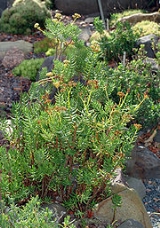
Crassula tetragona
Encyclopedia
Crassula tetragona is a succulent plant
native to Southern Africa
. It is widely distributed from the Orange River
boundary of Namaqualand
to beyond the Kei River in the Eastern Cape
. This species could have been introduced in 1711, but accounts are not clear. "Tetragona" comes from the phyllotaxy of the leaves. It is popularly named the "miniature pine tree" among ornamental plant enthusiasts, for its popular use as a "pine tree" in Bonsai.
The species was first described by Linnaeus in 1753 in his book Species Plantarum
There are six recognized subspecies, originally named by Tolken, as follows:
The subspecies are separated geographically, generally with only one subspecies per geographic area.
These plants are usually used as an ornamental, although they are believed to have been used as a medicinal plant by Thunberg, who wrote: "Crassula tetragona, somewhat of an stringent nature, boiled in milk, in the quantity of a handful, is used as a remedy for diarrhoea."
Succulent plant
Succulent plants, also known as succulents or fat plants, are water-retaining plants adapted to arid climates or soil conditions. Succulent plants store water in their leaves, stems, and also in roots...
native to Southern Africa
Southern Africa
Southern Africa is the southernmost region of the African continent, variably defined by geography or geopolitics. Within the region are numerous territories, including the Republic of South Africa ; nowadays, the simpler term South Africa is generally reserved for the country in English.-UN...
. It is widely distributed from the Orange River
Orange River
The Orange River , Gariep River, Groote River or Senqu River is the longest river in South Africa. It rises in the Drakensberg mountains in Lesotho, flowing westwards through South Africa to the Atlantic Ocean...
boundary of Namaqualand
Namaqualand
Namaqualand is an arid region of Namibia and South Africa, extending along the west coast over and covering a total area of 170,000 square miles/440,000 km². It is divided by the lower course of the Orange River into two portions - Little Namaqualand to the south and Great Namaqualand to the...
to beyond the Kei River in the Eastern Cape
Eastern Cape
The Eastern Cape is a province of South Africa. Its capital is Bhisho, but its two largest cities are Port Elizabeth and East London. It was formed in 1994 out of the "independent" Xhosa homelands of Transkei and Ciskei, together with the eastern portion of the Cape Province...
. This species could have been introduced in 1711, but accounts are not clear. "Tetragona" comes from the phyllotaxy of the leaves. It is popularly named the "miniature pine tree" among ornamental plant enthusiasts, for its popular use as a "pine tree" in Bonsai.
Habit and general description
The plant is erect or spreads shrubless to 1 m (3 ft). It has woody stems with brown bark, with crossed pairs of leaves. Leaves are green to dark green in color. The plant features terminal inflorescence ending in white flowers that come up in summer. The chromosome number varies: 2n=16, 32, 48.The species was first described by Linnaeus in 1753 in his book Species Plantarum
Species Plantarum
Species Plantarum was first published in 1753, as a two-volume work by Carl Linnaeus. Its prime importance is perhaps that it is the primary starting point of plant nomenclature as it exists today. This means that the first names to be considered validly published in botany are those that appear...
There are six recognized subspecies, originally named by Tolken, as follows:
- C. tetragona acutifolia
- C. tetragona tetragona
- C. tetragona rudis
- C. tetragona connivens
- C. tetragona lignescens
- C. tetragona robusta
The subspecies are separated geographically, generally with only one subspecies per geographic area.
These plants are usually used as an ornamental, although they are believed to have been used as a medicinal plant by Thunberg, who wrote: "Crassula tetragona, somewhat of an stringent nature, boiled in milk, in the quantity of a handful, is used as a remedy for diarrhoea."

